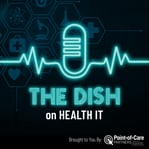Listen and Subscribe to Our Podcast
"The Dish on Health IT"
Engaging discussion around Health IT with perspectives from across the healthcare landscape. This informative and entertaining rotating panel of senior health IT consultants and their guests will keep you in the know about the latest innovations, policies and industry shifts impacting healthcare and point out the opportunities that lie within.

Subscribe on:
Apple Podcasts
Google Podcasts
Episode 5: Innovation in Health IT
Kurt Schiller and Mark Hughey from Arcweb join hosts, Gary Austin and Ken Kleinberg to talk about innovation in health IT. Our guests share what kind of innovative projects their Philadelphia-based software development firm is tackling, how they guide their clients through innovation projects and the importance of starting with a business use case before tackling a new project.
Ken Kleinberg kicked off the conversation by setting the stage around software innovation and the use of APIs. Ken explains that while many leading EHR softwares, despite their large R&D budgets, are still using decades old technologies. Many EHR companies have developed their own app stores, however, many of these have relied on proprietary technology. With the entrance of and expanded adoption of open APIs, there is a bigger opportunity fill in the gaps and impact patient experience in a big way.
Arcweb is in the world of innovation and acceleration rather than enterprise systems. Mark Hughey shared his analogy comparing Health IT innovation with a successful race car driving team. Hughey shared that a main focus of the innovation Arcweb is seeing is around patient experience, more specifically, technology being applied to better meet patient's changing expectations.
Kurt Schiller shared some examples of recent work completed which are examples of three different areas where there seems to be a lot of activity.
One example is patient scheduling. Rather than expecting patients to call the physician office to make an appointment there is a desire to allow patients to make appointments via an app. Up to now, the barrier was a business issue related to software architecture. Allowing patients to book an appt in two clicks versus
The next is around rare disease management to allow physicians to share data between themselves and augment their ability to treat patients with disease states they may not see frequently.
Finally, apps to support behavior change to better support disease state management.
Gary asked how Arcweb approaches new projects and how they go about planning the execution, timeframe and budget. Hughey empasized that they always begin by introducing customers to the idea of the iron triangle with three core pillars of scope, budget, and time. Two of these at any point can be optimized but never all three at once. This drives a conversation towards priorities so these are clearly articulated at project start. This helps Arcweb tailor the approach.
Gary then asked how they measure success. Hughey explains that key metrics of success are established from the beginning. This helps ensure the client team is on the same page with expectation.
Half of Arcweb's business is healthcare. Compared to other industries, healthcare key metrics of success are more confounding to set whether the client wants to improve patient experience, reduce administrative burden, improve clinical outcomes or some other metric.
Ken weighs in on key metrics of success by saying the conversation that reminds him of the old balance scorecard and that innovation/excitement measure could almost be added as an additional metric on the scorecard.
Gary then moves the conversation to talk about how COVID-19 has served as an accelerator for innovation planning. Schiller explains that many stakeholders realize there are gaps in data exchange inhibiting their response to the pandemic. Some decisions for short-term ease may cause some longer term issues but definitely have stakeholders looking more long-term with how they can build solutions that will better support telehealth and other areas in the longer term as well as revisiting frameworks and infrastructures.
The big challenge structurally is that even though you have innovation labs, core IT ops and research but in the case of research they don't have access to core IT and the purpose of core IT is to keep data safe and not innovation.
Key takeaway from Arcweb? As those responsible for bringing technology solutions to life to enhance the health and well being of those we serve, we should be unwilling to be less than we can be.




